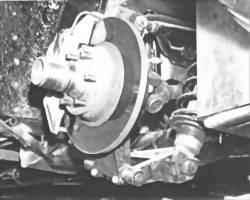First, Shelby's comment that "it works'' notwithstanding, that transverse leaf spring suspension had to go. Second, everything else had to be bigger and stronger to take the torque and the heft of the giant 427 inch power plant, a unit that was designed to push 4,000 pounds of brick-like sedan at 170 mph. In fact everything had to go but one item -surprisingly enough the standard Salisbury rear-end used in the 289 was found to be more than sufficient. |
|
||||
|
Integral coil-shocks, as used on virtually all modern race cars, were
selected both for compactness and ease of adjustment for chassis tuning.
This, naturally, necessitated a complete redesign of the front and rear
structures to carry the necessary upper A-arms that replaced the leaf springs
which formerly located the upper ends of the hub carriers. The frame tubes
went from three to four inches in diameter and were moved 22 inches apart,
from the original 17 as on the 289. The body design is that of the 1965
competition version and drops straight to the frame tubes instead of tucking
under as before. To make room for the bigger bellhousing the pedal support
box no longer straddles the frame, but is moved out with the widened tubes,
thus offsetting the pedals to the left. This is disconcerting at first, but
can be gotten used to in a day or so.
|
||||


